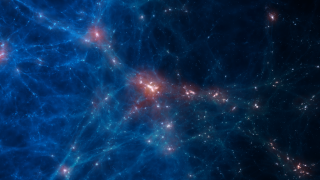Bibcode
Sawala, T.; Frenk, Carlos S.; Fattahi, Azadeh; Navarro, Julio F.; Bower, Richard G.; Crain, Robert A.; Dalla Vecchia, C.; Furlong, Michelle; Jenkins, Adrian; McCarthy, Ian G.; Qu, Yan; Schaller, Matthieu; Schaye, Joop; Theuns, Tom
Referencia bibliográfica
Monthly Notices of the Royal Astronomical Society, Volume 448, Issue 3, p.2941-2947
Fecha de publicación:
4
2015
Número de citas
202
Número de citas referidas
195
Descripción
The relation between galaxies and dark matter haloes is of vital
importance for evaluating theoretical predictions of structure formation
and galaxy formation physics. We use hydrodynamic cosmological
simulations of the Local Group to show that the widely used method of
abundance matching based on dark matter only simulations fails at the
low-mass end because two of its underlying assumptions are broken: only
a small fraction of low-mass (<109.5 M⊙)
haloes host a visible galaxy, and baryon effects lower their growth
rate. In this regime, reliance on dark matter only simulations for
abundance matching is inappropriate and can lead to incorrect results.
We find that the reported discrepancy between observational estimates of
the halo masses of dwarf galaxies and the values predicted by abundance
matching does not point to a failure of Λ cold dark matter, but
simply to a failure to account for baryonic effects. Our results also
imply that the Local Group contains only a few hundred observable
galaxies in contrast with the thousands of faint dwarfs that abundance
matching would suggest. We show how relations derived from abundance
matching can be corrected, so that they can be used self-consistently to
calibrate models of galaxy formation.
Proyectos relacionados

Astrofísica Numérica: Formación y Evolución de Galaxias
Entre las cuestiones fundamentales en Astronomía y Astrofísica están la formación y evolución de galaxias. Las escalas de tiempo y tamaño son tan astronómicas que su observación en galaxias individuales es imposible. Solo con el uso de simulaciones numéricas es posible entender la formación de estructuras cósmicas dentro del actual marco
Claudio
Dalla Vecchia